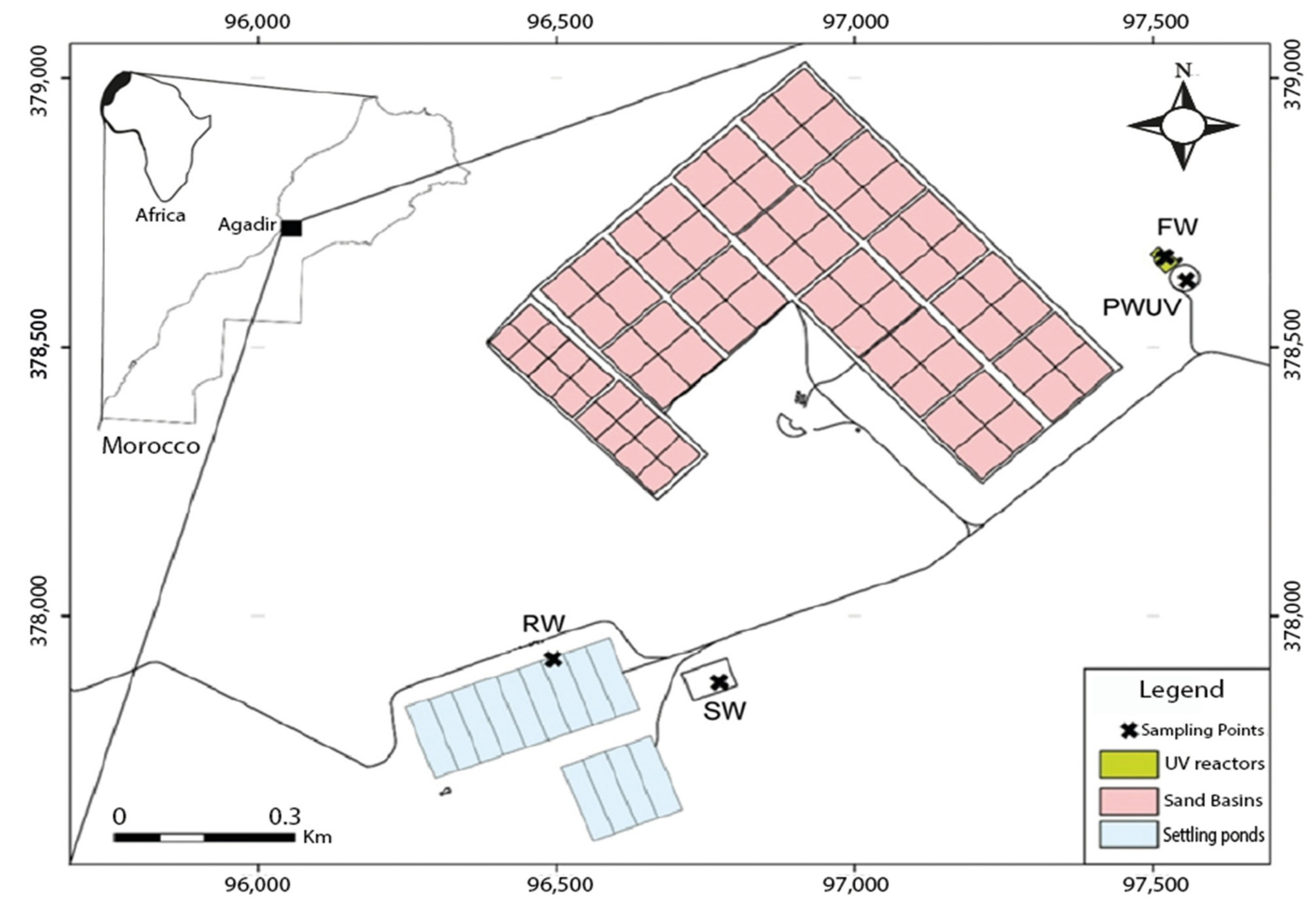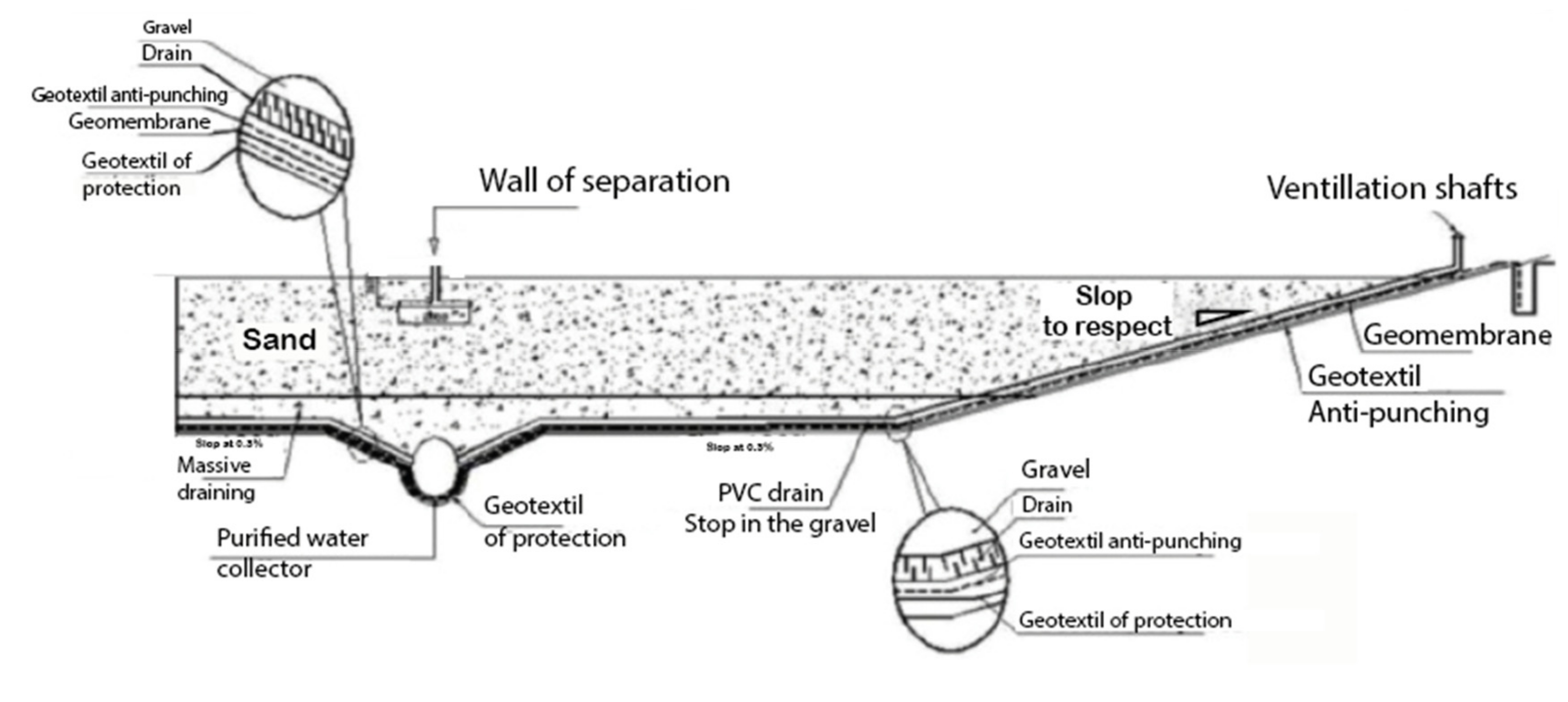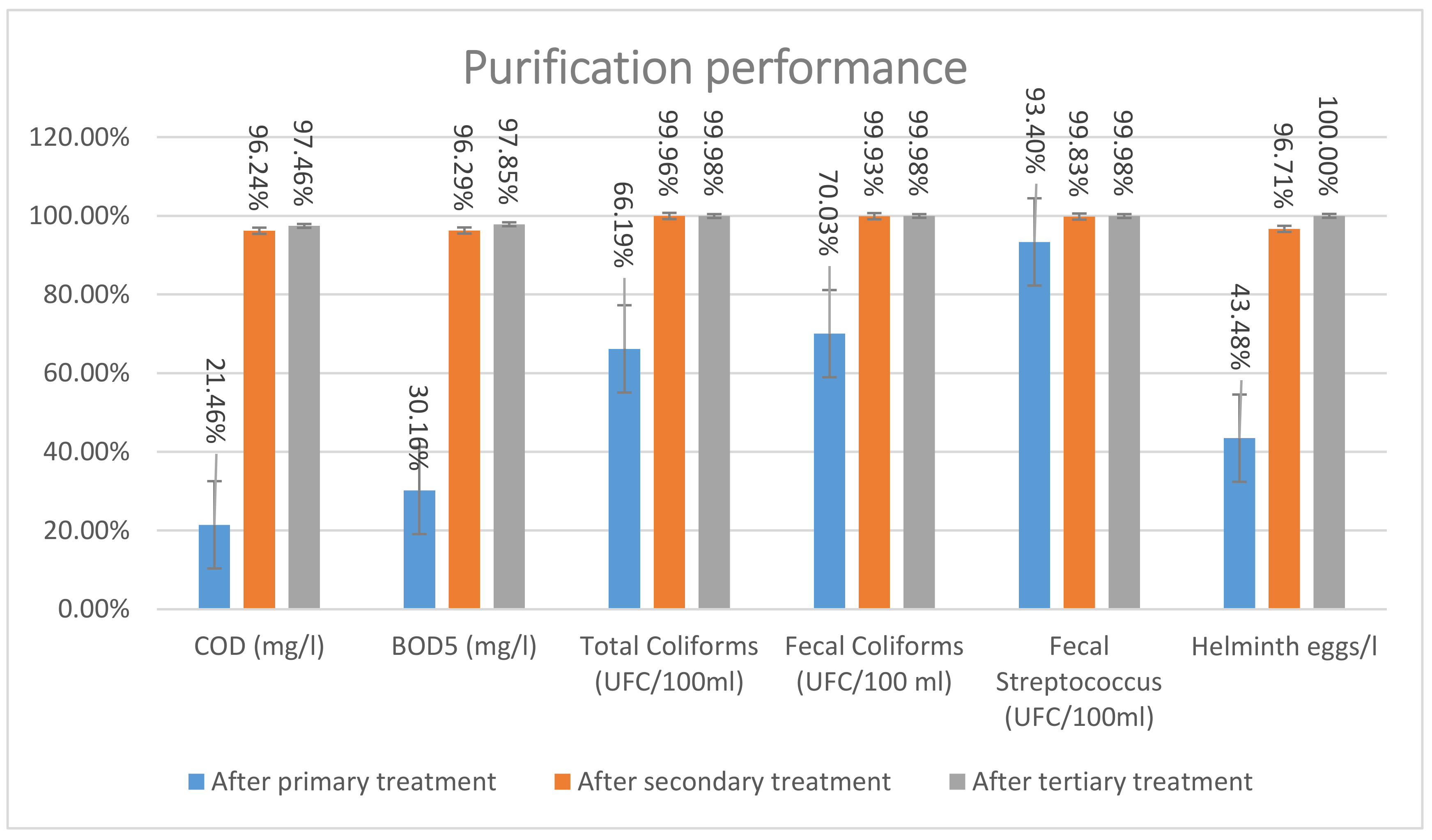Evaluation of the Performance and Quality of Wastewater Treated by M’zar Plant in Agadir, Morocco
Abstract
1. Introduction
2. Materials and Methods
2.1. Geographic Location of M’zar Wastewater Treatment Plant
2.2. M’zar Wastewater Treatment Plant Description
- Sand filter treatment systems are extremely “Passive”. That means there is minimal mechanical equipment that require replacement. This saves cost and does require skilled personnel.
- You get an environmentally “green” process which produces valuable reusable water for lawn or garden requirements.
- Negligible electrical power consumption: The filter and effluent pumps operate for approximately 10 min/day. A solar option is also available.
- Natural disinfection: No chemicals to create negative environmental impacts. Furthermore, sand filter treatment systems have the added ability to reduce and remove viruses and helminths from secondary effluent.
- Proven to generate an extremely consistent and high-quality effluent and can tolerate wide hydraulic or organic loading fluctuations.
- The sand filter sewerage treatment system is a scalable technology suitable for commercial, industrial and institutional settings.
2.2.1. Pretreatment: Screening, Grit Removal, Degreasing
2.2.2. Primary Treatment: Anaerobic Lagoons
2.2.3. Secondary Treatment: Infiltration Percolation on a Sandy Bed
- Physical mechanisms: Retention on the filter surface of almost all suspended solids in the effluent and the largest pathogenic micro-organisms (parasites).
- Biological mechanisms: Oxidation of the organic substances and oxidizable nitrogen dissolved in the effluent during its slow percolation and in the presence of the gas phase oxygen of the filter, in addition to a degradation of microorganisms (germs) trapped in the pores or adsorbed on the surface of the grains [4].
2.2.4. Tertiary Treatment: Ultraviolet Disinfection
2.2.5. Sludge Treatment
2.3. Water Sampling
2.4. Physico-Chemical and Bacteriological Analysis
2.5. Pollutants Removal at the M’zar Plant
3. Results
3.1. Physico-Chemical and Bacteriological Parameters
3.1.1. Temperature, pH and Electrical Conductivity (EC)
3.1.2. COD, BOD5 and SM
3.1.3. Nitrates, Total Nitrogen Kjeldahl and Ammonium
3.1.4. Fecal Coliforms, Fecal Streptococcus and Helminth Eggs
3.2. Ratios of Global Wastewater Pollution Parameters
3.3. Station Performance
4. Discussion
4.1. Physico-Chemical and Bacteriological Parameters
4.2. Advantage of Wastewater Reuse for the Region
4.2.1. Water Saving
4.2.2. Fertilizer Supply
4.2.3. Sludge Digestion and Biogas Production
5. Conclusions
- -
- Separation and collection of the brine before its discharge into the sewerage system.
- -
- Generalization of the pre-treatment system to all fishery industries.
- -
- Understanding the impacts of treated wastewater irrigation and having the tools to manage them is critical. As such, a long-term study of the impacts of using this water resource is mandatory.
Author Contributions
Funding
Institutional Review Board Statement
Informed Consent Statement
Data Availability Statement
Acknowledgments
Conflicts of Interest
References
- Ministère de l’Equipement, du Transport, de la Logistique et de l’Eau, Département de l’Eau, Ressources en Eau, Agence du Bassin Hydraulique du Souss-Massa. Available online: http://www.water.gov.ma/ressources-en-eau/agence-de-bassins-hydrauliques-abh/abh-souss-massa/ (accessed on 9 May 2019).
- Choukr-Allah, R.; Nghira, A.; Hirich, A.; Bouchaou, L. Water resources master plan for sustainable development of the Souss-Massa river basin. In The Souss-Massa River Basin, Morocco; Springer: Cham, Switzerland, 2016; pp. 1–26. [Google Scholar]
- Bourouache, M.; Mimouni, R.; Alla, A.A.; Hamadi, F.; El Boulani, A.; Bihadassen, B. Bacteriological and physicochemical quality of treated wastewater of the Mzar treatment plant. Appl. Water Sci. 2019, 9, 86. [Google Scholar] [CrossRef]
- Independent Multi-Service Agency Agadir (RAMSA). M’Zar treatment station. In Water Supply Serv. Agadir (Régie Auton. Multiservices d’Agadir); RAMSA: Agadir, Maroko, 2002; Available online: http://www.ramsa.ma/Accueil/EspaceTechnique/Assainissement/Assainissementliquide/StationdetraitementMZar.aspx (accessed on 5 March 2019).
- El Ouali Lalami, A.; Zanibou, A.; Bekhti, K.; Zerrouq, F.; Merzouk, M. Contrôle de la qualité microbiologique des eaux usées domestiques et industrielles de la ville de Fès au Maroc (Microbiological Control wastewater domestic and industrial city of Fes Morocco). J. Mater. Environ. Sci. 2014, 5, 2325–2332. [Google Scholar]
- Azizi, A.; Lamgaddam, M.; Jad, M. Guide Pour Les Activités d’hygiène du Milieu en Zone Rurale; Fonds des Nations Unies Pour l’UNICEF: Rabat, Morocco, 1990; Volume 10, p. s0140-6736. [Google Scholar]
- Rodier, J.; Legube, B.; Merlet, N.; Brunet, R. Water Analysis: Natural Waters, Wastewaters, Sea Water; Dunod: Paris, France, 2005; p. 1384. [Google Scholar]
- Fagrouch, A.; Amyay, S.; Berrahou, A.; El Halouani, H.; Abdelmoumen, H. Performances d’abattement des germes pathogènes en lagunage naturel sous climat aride: Cas de la filière de traitement des eaux usées de la ville de Taourirt. Afr. Sci. 2010, 6, 87–102. [Google Scholar]
- Ministry of Land of Morocco. Normes Marocaines, Official Bulletin of Morocco; No. 5062 du 30 Ramadan 1423; Ministry of Land of Morocco: Rabat, Morocco, 2002.
- Bechac, J.P.; Boutin, P.; Mercier, B.; Nuer, P. Traitements des eaux usées; Eyrolles: Paris, France, 1987. [Google Scholar]
- Office National de l’Electricité et de l’Eau Potable. Caractérisation Quantitative et Qualitative des Eaux Usées; Office National de l’Electricité et de l’Eau Potable: Rabat, Morocco, 1999.
- Mouhanni, H.; Bendou, A.; Er-Raki, S. Disinfection of treated wastewater and its reuse in the irrigation of golf grass: The case of plant M’zar Agadir-Morocco. Water 2011, 3, 1128–1138. [Google Scholar] [CrossRef]
- HMF. Paramètres d’Analyses de la Pollution des Eaux. 2004. Available online: http://hmf.enseeiht.fr/travaux/CD0304/optsee/bei/5/binome5/index5.html (accessed on 10 January 2020).
- Mimouni, R.; Yacoubi, B.; Eddabra, R. Physicochemical quality of wastewater purified by infiltration-percolation: Case of the plant of Ben Sergao (south-western Morocco) after ten years of running. Rev. Microbiol. Ind. San. Environ. 2011, 5, 101–114. [Google Scholar]
- Hajji, C.; Bendou, A.; Hassou, M. Caractérisation des rejets liquides d’une unité de réparation navale à Agadir. Rev. Int. Tech. 2013, 45, 29–36. [Google Scholar]
- Jeison, D.; Kremer, B.; Van Lier, J.B. Application of membrane enhanced biomass retention to the anaerobic treatment of acidified wastewaters under extreme saline conditions. Sep. Purif. Technol. 2008, 64, 198–205. [Google Scholar] [CrossRef]
- Touyer, O.; Zekhnini, A.; Rondelaud, D.; Moukrim, A. Incidence des helminthoses intestinales chez les enfants vivant dans la zone d’épandage des eaux usées d’Aghroud, agglomération d’Agadir (Sud du Maroc). In Bulletin de la Société Française de Parasitologie; En línea: Paris, France, 1998; Volume 16, pp. 298–304. [Google Scholar]
- Et-taleb, S.; Elhaouti, R.; Abbaz, M.; Lhanafi, S.; Ez-zahery, M.; Aba-aaki, R.; El Alem, N. Comparaison du phénomène de colmatage des eaux usées à travers deux types de sables: L’un vierge et l’autre utilisé lors de traitement par infiltration (Comparison of the clogging phenomenon wastewater through two types of sand: One virgin and one used during treatment with infiltration). J. Mater. Environ. Sci. 2014, 5, 1906–1912. [Google Scholar]
- El Haouti, R.; Et-taleb, S.; Abbaz, M.; Lhanafi, S.; Azougarh, Y.; Ez-Zahery, M.; El Alem, N. The use of titaniferous sieved sand for the treatment of domestic wastewater in the percolation infiltration process. Arab. J. Chem. Environ. Sci. 2015, 2, 58–71. [Google Scholar]
- Mimouni, R.; Alla, A.A.; Anajjar, E.M.; Finance, C.; Moukrim, A. Impact du rejet des eaux usées sur la qualité microbiologique des plages de la baie d’agadir (Maroc). J. Eur. Hydrol. 2002, 33, 115–123. [Google Scholar] [CrossRef]
- Gillet, P.; Gormann, E.; Tallec, P.; Moukrim, A.; Mouloud, M.; Ait Alla, A.; Kaaya, A. Impacts des rejets urbains sur les communautés benthiques intertidales de l’embouchure de l’Oued Souss, baie d’Agadir, Maroc. J. Rech. Océanogr. 2003, 28, 39–44. [Google Scholar]
- Arnal, J.M.; León, M.C.; Lora, J.; Gozálvez, J.M.; Santafé, A.; Sanz, D.; Tena, J. Ultrafiltration as a pre-treatment of other membrane technologies in the reuse of textile wastewaters. Desalination 2008, 221, 405–412. [Google Scholar] [CrossRef]
- Zhao, F.; Xi, S.; Yang, X.; Yang, W.; Li, J.; Gu, B.; He, Z. Purifying eutrophic river waters with integrated floating island systems. Ecol. Eng. 2012, 40, 53–60. [Google Scholar] [CrossRef]
- Quevedo, N.; Sanz, J.; Lobo, A.; Temprano, J.; Tejero, I. Filtration demonstration plant as reverse osmosis pretreatment in an industrial water treatment plant. Desalination 2012, 286, 49–55. [Google Scholar] [CrossRef]
- El Hafiane, F.; Rami, A.; El Hamouri, B. Mécanismes d’élimination de l’azote et du phosphore dans un chenal algal à haut rendement. J. Water Sci. 2003, 16, 157–172. [Google Scholar] [CrossRef][Green Version]
- Eddabra, R. Evaluation de la Contamination Bacteriologique des Eaux Usées des Stations d’Épuration du Grand Agadir: Isolement, Caracterisation Moleculaire et Antibioresistance des Espèces du Genre Vibrio. Ph.D. Thesis, Université de Strasbourg, Strasbourg, France, 2011. [Google Scholar]
- Mouhanni, H.; Bendou, A.; Houari, M. Study of the Wastewater Purifying Performance in the M’Zar Plant of Agadir, Morocco. Environ. Pollut. 2013, 2, 20. [Google Scholar] [CrossRef][Green Version]
- Choukr-Allah, R.; Thor, A.; Young, P.E.; Hamdy, A. Domestic wastewater treatment and agricultural reuse in Drarga, Morocco. In The Use of Non-Conventional Water Resources; CIHEAM/EU DG Research: Bari, Italy, 2005; pp. 147–155. [Google Scholar]
- FAO. Etat des Lieux, Diagnostic et Analyse de la Réutilisation des Eaux Usées Traitées; Cas du Maroc; Projet TCP/SNE/3701; FAO: Rome, Italy, 2020. [Google Scholar]
- Atelier sur l’Assainissement, l’Épuration et la Réutilisation des Eaux Usées. Projet d’Assainissement, d’éPuration et de Valorisation des Sous Produits de la Station d’Épuration du Mzar du Grand Agadir. 2015. Available online: http://www.susana.org/_resources/documents/default/2-1722-atelier-assainissement-agadir.pdf (accessed on 16 March 2019).
- Organisation des Nations Unies Pour l’Alimentation et l’Agriculture (FAO). Agriculture et Rareté de l’Eau: Une Approche Programmatique Pour l’Efficacité de l’Utilisation de l’Eau et la Productivité Agricole; FAO: Rome, Italy, 2007; p. 15. [Google Scholar]




| Primary Treatment: Anaerobic Decantation | Secondary Treatment: Infiltration Percolation | Tertiary Treatment: UV Disinfection | ||||
|---|---|---|---|---|---|---|
| Treatment capacity | 75,000 m3/day | Treatment capacity | 30,000 m3/day | Treatment capacity | 30,000 m3/day | |
| Number of decanters | 13 | Number of filters | 24 | Number of Pumps | 7 including one emergency | |
| Decanter length | 115 m | Surface of each filter | 5000 m2 | Flow rate of each pump | 270 m3/h | |
| Decanter width | 35 m | Thickness of the filter | 2 m of sand | Number of Reactors | 6 | |
| Depth of the decanter at the dispense zone | 6.59 m | Thickness of the gravel | 0.5 m | Capacity of each reactor | 5000 m3/day | |
| Depth of the decanter at the lagoon zone | 4.24 m | Infiltration rate | 1 m/day | Lamps | Number per reactor | 14 low-pressure Amalgam lamps |
| Wavelength | 254 nm | |||||
| Exposure dose | 50 mJ/cm2 | |||||
| Volume of each decanter | 16,000 m3 | Filter bottom sealing material | 1 mm thick of HDPE geomembrane | Lifetime | 16,000 h | |
| Contact time | 4 s | |||||
| Raw Water (RW) | Settled Water (SW) | Filtered Water (FW) | Purified Water (PWUV) | |||||||||||||
|---|---|---|---|---|---|---|---|---|---|---|---|---|---|---|---|---|
| Parameters | Average | MAX | MIN | SD | Average | MAX | MIN | SD | Average | MAX | MIN | SD | Average | MAX | MIN | SD |
| Temperature (°C) | 21.4 | 27.8 | 18 | 2.6 | 21.4 | 27.2 | 18.6 | 2.5 | 21.6 | 27.7 | 18.2 | 2.5 | 21.7 | 28.2 | 18.5 | 2.8 |
| pH at 25 °C | 7.2 | 7.5 | 6.8 | 0.2 | 7.3 | 7.6 | 7 | 0.2 | 7.5 | 7.9 | 6.5 | 0.3 | 7.8 | 8.4 | 6.5 | 0.4 |
| Conductivity at 25 °C | 4049 | 7310 | 2750 | 1115 | 3698 | 4740 | 2810 | 567.1 | 3802 | 4610 | 3180 | 401.5 | 3752 | 4430 | 3000 | 437 |
| SM (mg/L) | 522.3 | 810 | 218 | 150.5 | 304.7 | 640 | 32 | 157.3 | 13.3 | 55 | 3 | 13.5 | 7.1 | 16 | 3 | 3.7 |
| Total nitrogen Kjeldahl (mg/L) | 142.2 | 230 | 98 | 35.3 | 130.3 | 218.4 | 84.8 | 32.5 | 5.8 | 14 | 0.06 | 4.8 | 4.3 | 10.3 | 0.4 | 3.6 |
| Nitrates (mg/L) | 1.1 | 6 | 0.1 | 1.3 | 0.8 | 2.4 | 0.1 | 0.5 | 288.4 | 384 | 220.2 | 45.6 | 289.2 | 390.9 | 212.5 | 46.8 |
| Ammonium (mg/L) | 116.7 | 221.8 | 70 | 40.4 | 115.6 | 204.5 | 74.5 | 32.4 | 4 | 11 | 0.06 | 3.8 | 2.6 | 8 | 0.1 | 2.7 |
| COD (mg/L) | 953.5 | 1433.7 | 718.2 | 196 | 727.9 | 921 | 579.2 | 105 | 35.8 | 60.7 | 8.2 | 14.2 | 24.6 | 45.7 | 5.7 | 10.7 |
| BOD5 (mg/L) | 399.6 | 568.4 | 302.8 | 71.7 | 274.9 | 355 | 115.7 | 59.3 | 14.5 | 25.3 | 3.6 | 5.3 | 9.0 | 15.9 | 3.9 | 3.4 |
| Fecal Coliforms (UFC/100 mL) | 1.56 × 109 | 2.4 × 1010 | 1.2 × 105 | 5.78 × 109 | 3.16 × 107 | 1.5 × 108 | 2900 | 4.75 × 108 | 840.13 | 5000 | 7 | 1562.4 | 50 | 290 | 0 | 81.5 |
| Fecal Streptococcus (UFC/100 mL) | 1.61 × 109 | 2 × 1010 | 10 × 103 | 4.90 × 109 | 1.27 × 107 | 1.20 × 108 | 130 | 3.16 × 107 | 158 | 600 | 0 | 198.22 | 34.1 | 320 | 0 | 78.3 |
| Helminth eggs/L | 23.3 | 27 | 19 | 2.3 | 13 | 19 | 8 | 3 | 1 | 5 | 0 | 1.5 | 0 | 0 | 0 | 0 |
| Raw Water | Settled Water | Filtered Water | Purified Water | |||||
|---|---|---|---|---|---|---|---|---|
| Parameters | Average | SD | Average | SD | Average | SD | Average | SD |
| COD (mg/L) | 953.58 | 196.03 | 727.96 | 105.07 | 35.83 | 14.21 | 24.66 | 10.71 |
| BOD5 (mg/L) | 399.64 | 71.74 | 274.91 | 59.33 | 14.54 | 5.33 | 9.05 | 3.40 |
| SM (mg/L) | 522.34 | 150.56 | 304.79 | 157.33 | 13.37 | 13.57 | 7.08 | 3.73 |
| COD/BOD5 | 2.39 | 0.33 | 2.65 | 0.66 | 2.46 | 0.41 | 2.73 | 0.37 |
| SM/BOD5 | 1.31 | 0.36 | 1.11 | 0.52 | 0.92 | 1.50 | 0.78 | 0.76 |
| MO | 584.28 | 105.18 | 425.93 | 71.13 | 21.63 | 8.07 | 14.25 | 5.75 |
| Cultivation | Neat Benefit on Water (Dh/Year/Inhab) | Benefit on Fertilizers (Dh/Year/Inhab) | Total Benefit (Dh/Year/Inhab) |
|---|---|---|---|
| Tender Wheat | 750 | 1492 | 2242 |
| Corn | 1558 | 3614 | 5202 |
| Fodder corn | 1568 | 3572 | 5140 |
| Clover | 774 | 1539 | 2313 |
| Zucchini | 677 | 1545 | 2222 |
| Squash | 611 | 1216 | 1827 |
| Tomato | 1553 | 3542 | 5095 |
Publisher’s Note: MDPI stays neutral with regard to jurisdictional claims in published maps and institutional affiliations. |
© 2021 by the authors. Licensee MDPI, Basel, Switzerland. This article is an open access article distributed under the terms and conditions of the Creative Commons Attribution (CC BY) license (https://creativecommons.org/licenses/by/4.0/).
Share and Cite
Mansir, I.; Oertlé, E.; Choukr-Allah, R. Evaluation of the Performance and Quality of Wastewater Treated by M’zar Plant in Agadir, Morocco. Water 2021, 13, 954. https://doi.org/10.3390/w13070954
Mansir I, Oertlé E, Choukr-Allah R. Evaluation of the Performance and Quality of Wastewater Treated by M’zar Plant in Agadir, Morocco. Water. 2021; 13(7):954. https://doi.org/10.3390/w13070954
Chicago/Turabian StyleMansir, Imane, Emmanuel Oertlé, and Redouane Choukr-Allah. 2021. "Evaluation of the Performance and Quality of Wastewater Treated by M’zar Plant in Agadir, Morocco" Water 13, no. 7: 954. https://doi.org/10.3390/w13070954
APA StyleMansir, I., Oertlé, E., & Choukr-Allah, R. (2021). Evaluation of the Performance and Quality of Wastewater Treated by M’zar Plant in Agadir, Morocco. Water, 13(7), 954. https://doi.org/10.3390/w13070954







